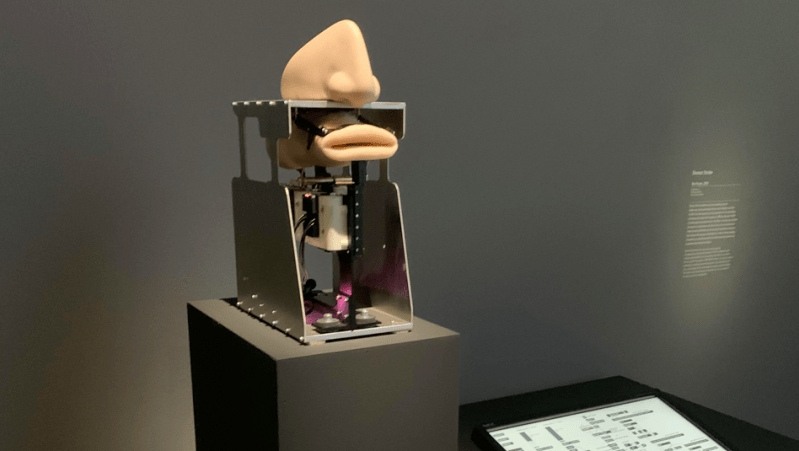Even in a world that is as currently far off the rails as this one is, we’re going to go out on a limb and say that this machine learning, servo-powered prayer bot is going to be the strangest thing you see today. We’re happy to be wrong about that, though, and if we are, please send links.
“The Prayer,” as [Diemut Strebe]’s work is called, may look strange, but it’s another in a string of pieces by various artists that explores just what it means to be human at a time when machines are blurring the line between them and us. The hardware is straightforward: a silicone rubber representation of a human nasopharyngeal cavity, servos for moving the lips, and a speaker to create the vocals. Those are generated by a machine-learning algorithm that was trained against the sacred texts of many of the world’s major religions, including the Christian Bible, the Koran, the Baghavad Gita, Taoist texts, and the Book of Mormon. The algorithm analyzes the structure of sacred verses and recreates random prayers and hymns using Amazon Polly that sound a lot like the real thing. That the lips move in synchrony with the ersatz devotions only adds to the otherworldliness of the piece. Watch it in action below.
We’ve featured several AI-based projects that poke at some interesting questions. This kinetic sculpture that uses machine learning to achieve balance comes to mind, while AI has even been employed in the search for spirits from the other side.
[Via Twitter, but we recommend abstaining from the comments, for obvious reasons.]
















Will not make oral sex joke, will not make oral sex joke, WILL NOT MAKE ORAL SEX JOKE…
You are doing a great job so far.
That’s what she said
Giggity
To be honest… The first thing I saw was the picture and a prayerbot was not what I thought it was for :D
Especially because I do not know, what an “intercessor” is. (As English is not my first language.)
lay it on its side. not sure what the nose could be used for. oh wait make it vibrate and leave orientation. guess it works both side. got a head of itself.
Turn that sideways and change the sound effects and you may be onto something.
Disappointing. Whats the point of recreating a nasopharyngeal cavity if your not going to have lips teeth and tongue form the words? It’s just a speaker with flapping lips!
https://www.youtube.com/watch?v=HmSYnOvEueo
Isn’t that the definition of a television reporter or was that a politician
So true on many levels..
Was totally hoping for some more modern take (or ever recreation) of “voder” technology.
Leaving disappointed*
*minus the the tongue-in-cheek framing..
Lips are there somehow. And teeth could impair it’s dual use function :-) But the tongue is obviously missing.
self explanatory…… smh ….
https://www.youtube.com/watch?v=iNvJ7VgPrTU
+ 1 Thanks :-]
We can all use a little bit of funny stuff now!
The usefulness of this kind of artist really shines in today times. They need to try harder to be provocative, flat bait.
Are you trying to end the world faster? Because this is how you end the world faster.
https://en.wikipedia.org/wiki/The_Nine_Billion_Names_of_God
Surely this is a piece critical of organized religion? If this were serious, it would be hilarious. I do not get the message though. It is like beating a dead and putrid horse at this point in time. For all the problems religion still pose on society, it is far from leading.
Nah. I’m going more about our relationship with and hopes/fears for AI. Will AIs need to pray? In which faith will they believe? Etc.
They won’t… it’s a robot. It’s been built upon the technology of sophisticated intelligence. I’m sure they won’t program in archaic folklore. Look at the problems religion created for human beings.
This is going to be a common theme in weeks to come with people with too much time on their hands
Perhaps now I can finish my art project. A animatronic piglet that sequels the Qu’ran in Hebrew…
This is something similar from 2011.
https://www.youtube.com/watch?v=HmSYnOvEueo
Not sure if things have advanced all that much since then or not?
Pretty disappointing. I was hoping that the mouth position would correspond to the human vocal tract’s formation, but instead it appears that the mouth is just opened by the volume of the sound. I was working on trying to make more realistic mouth movement by doing spectral analysis but that project has lost momentum. Higher overtone content is usually correlated with the teeth being together, as with the “s” sound, while lower frequency sounds usually correspond to the mouth being more open and round, as the “ah” sound.
This is just cheating. Like putting a motor on a prayer wheel. And I want to get the rest of the theory that prayer is communicated via audio. (And any other theory – for example, the brain maps to a hyperspace that is the substrate of the Great AI.)
The prayer wheel could itself already be called “cheating”. But prayer anyway way has no physical effect at all. So any form the believer wants to give it, is adequate for it’s purpose. Which is not more than calming down the praying believer(s).
The AI is spot on. It’s the first I’ve heard that makes any sense.